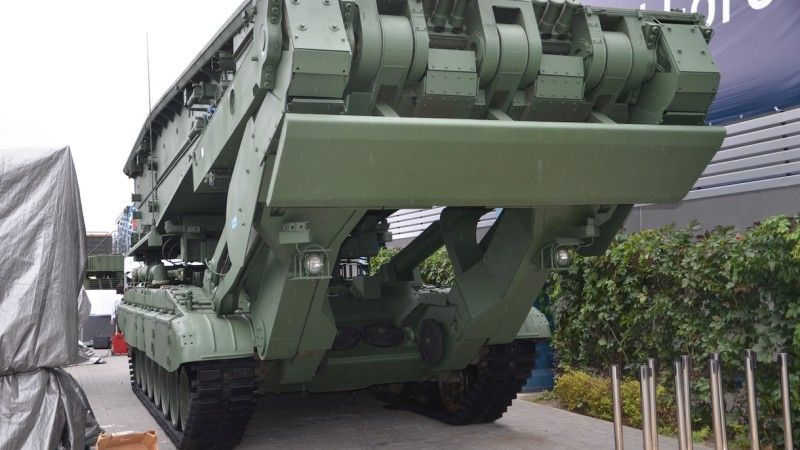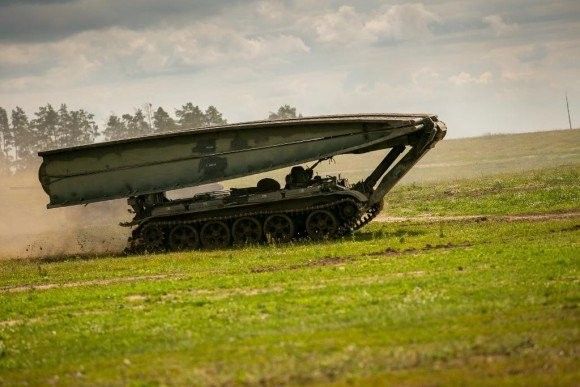Armed Forces
100 Bridges for the Polish MBTs. Question of the Platform

Photo. Maciej Szopa/Defence24.pl
The Armament Agency is willing to procure new assault bridges from the Polish industry. These would be expected to support the K2PL and Abrams tank elements. No final decisions have been made regarding the base platform for those.
In April, the Armament Agency launched a preliminary market consultation on acquiring MG-20 Daglezja assault bridges. Consultations, as is usual in such circumstances, are aimed at an initial assessment of the possibility of fulfilling the requirements, clarification of the conditions concerning the acquisition of equipment, as well as logistics and training, preliminary setting of deadlines and cost estimates, and establishing the possibility of securing the delivery, including by directing orders for the production and servicing of equipment to the Polish defence industry.
The consultation process is to be taking place until 30th June. Defence24.pl was informed by Lieutenant Colonel Grzegorz Polak, spokesman for the Armament Agency, that three entities entered the procedure: consortium formed by Rheinmetall Polska Sp. z o.o. and Wojskowe Zakłady Motoryzacyjne S.A., Ośrodek Badawczo Rozwojowy Urządzeń Mechanicznych »OBRUM« Sp. z o.o. and Hyundai Rotem Company. Lt. Col. Polak added that the Armament Agency, at this stage at least, has not designated the specific type of base platform on which the bridges should be based.
The description of the subject matter of the contract published by the Armament Agency on its website shows that the bridge on the tracked platform is expected to allow main battle tanks and other vehicles to cross obstacles, with the bridges being capable of handling MLC80/120 load. In practice, this means that even main battle tanks weighing more than 70 tonnes (a similar weight could be associated with the Abrams in its latest version if additional armour and an active protection system are included) and the tank transporters carrying those main battle tanks could cross those bridges. The bridges are to comply with the STANAG 4569 Level V protection norm. The bridge is also expected to feature the Obra-3 laser warning receiver. The whole package should also include logistics and training support bundles.
Among the three entities that entered the technical dialogue are Gliwice-based OBRUM, which, together with Bumar-Labędy, developed the original version of the MG-20 Daglezja-G bridge, Hyundai Rotem, the manufacturer of the K2PL tank, and Poznan-based WZM, participating in the procedure together with the Polish Rheinmetall’s company.
One of the questions that perhaps the consultation and possibly subsequent analytical work will answer will be about the bridge chassis. While the MG-20 prototype was based on a modified T-72 tank chassis, this selection is very unlikely, almost impossible, as the T-72 tanks are being withdrawn from the Polish Armed Forces. They are being replaced by new platforms. K2PL seems to be the obvious candidate, but other options are also potentially on the table.

Photo. st. szer. Adrian Jórski, st. chor. sztab. Mariusz Kraśnicki
It is assumed that 120 bridges will be procured, with deliveries scheduled between 2026 and 2035. This should provide equipment for existing and newly formed units, replacing the BLG-67M2 self-propelled bridges based on the T-55 main battle tank, along with a small number of German Leopard 1-based Bibers, acquired in the early 2000s with the first batch of Leopard 2A4 tanks.
Currently, as far as self-propelled bridges are concerned, the Polish Army operates - in small numbers - a far more modern solution, the Daglezja-S system (MS-20, belonging to the same family as the MG-20), and last year more than 40 systems as such have been ordered. However, the first series of modern tracked chassis bridges for the Polish Army will not be the MG-20s, but Joint Assault Bridges based on Abrams main battle tanks, as a total of 25 such vehicles have been ordered under two FMS Abrams main battle tank procurement contracts, in 2022 and 2023. Undoubtedly, the MG-20 programme, as well as other procurement programmes aimed at the acquisition of new-generation support vehicles for modern main battle tanks and fighting vehicle units, are very much needed - so that the new tanks or howitzers can fully utilize their combat qualities and potential.

Photo. US Army
